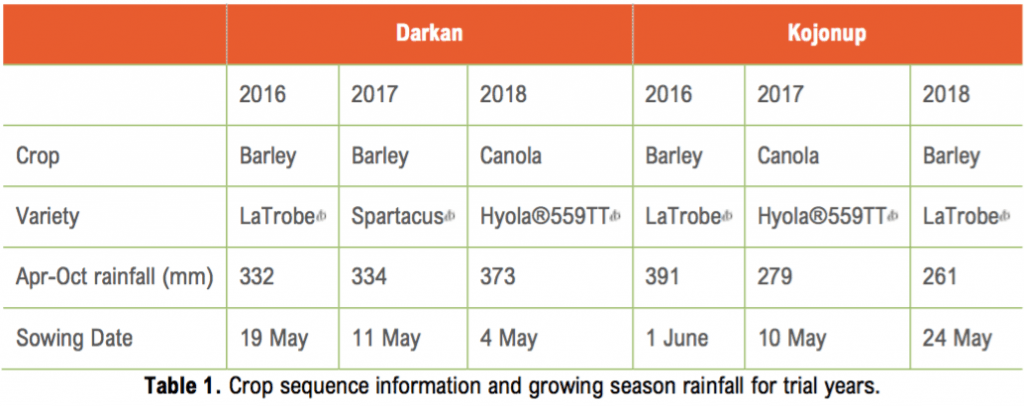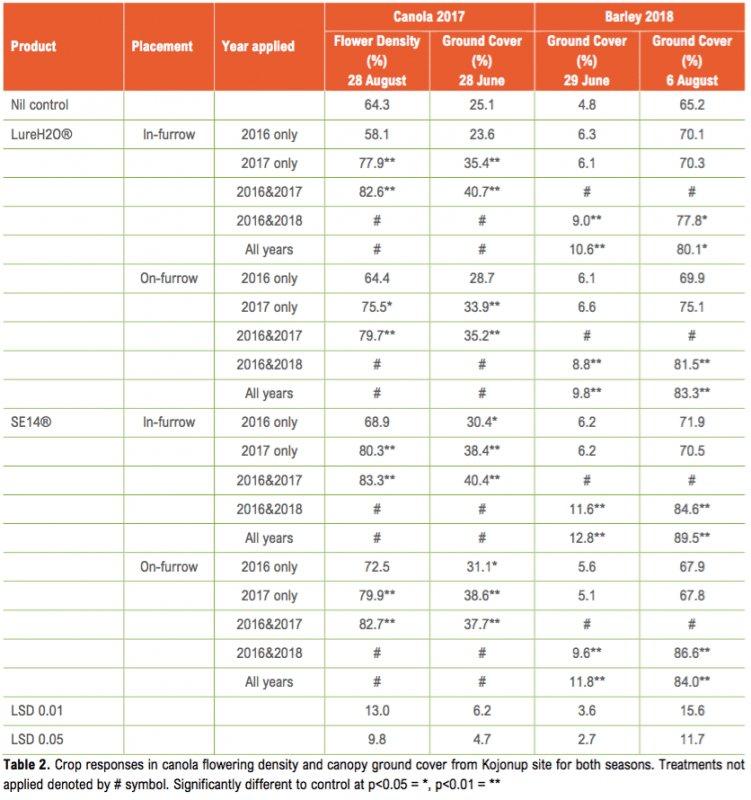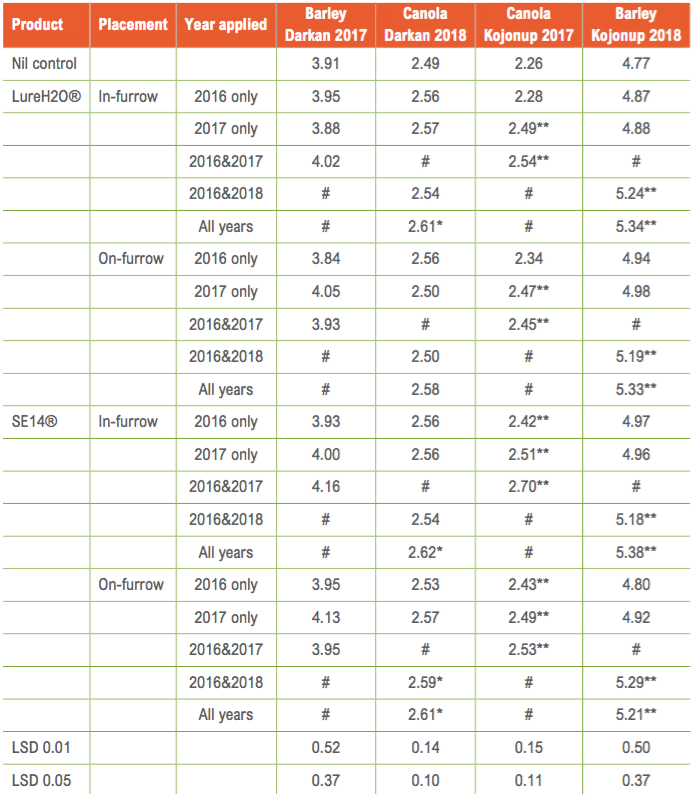
Research Authors:
By G.P. McDonald – Department of Primary Industries and Regional Development, 444 Albany Highway, Albany, WA
& S.L. Davies – 6330, 2 Department of Primary Industries and Regional Development, 20 Gregory St, Geraldton, WA, 6530
Aim
Two small plot research experiments were established in 2016 at Darkan and Kojonup to investigate the longevity of banded soil wetting agents in duplex sandy gravel and loamy gravel soils in South-West Western Australia. The experiments were designed to test residual or additive effects of the soil wetters by either applying or excluding them in different years to achieve different cumulative rates over the length of the trial.
Background
Soil water repellence (SWR) is a significant constraint to crop establishment in South-West Western Australia (WA) cropping zone, with 9.9M ha at risk (van Gool 2016).
To improve crop establishment on the forest gravel soils common to this region it is common practice to routinely apply wetting agents to overcome this repellence. Since this is an annual cost, many growers are questioning whether there are situations where they can avoid these applications such as when the soil is not dry at sowing and whether doing this will negatively affect subsequent crop performance.
There is anecdotal evidence from growers that some soil wetting agents have residual properties that improve crop performance in seasons following the year of application. Two field experiments were undertaken to evaluate the potential residual activity of wetting agents over multiple seasons and whether the location of their placement in the seed bed affects the residual effect.
Experiment Details
Two field experiments were established in 2016 on water repellent soil at Darkan (-33.4962, 116.7042) and Kojonup (-34.1243, 117.1987) in WA. The soils are a duplex sandy gravel (Ferric Chromosol) and a loamy gravel (Ferric Kandosol) respectively that are both common (1.7M ha combined, van Gool 2018) across large areas of the South-West WA higher rainfall zones.
Using the molarity of ethanol droplet (MED) test, The SWR was rated as severe for both experiments (MED = 4.2 and 3.8 respectively). The experiments compared two commercial soil wetting agents (SACOA’s LureH2O® and SE14®) banded at label rates at sowing.
Two wetting agent placement techniques were also compared, either banded in-furrow near the seed or banded on the surface of the furrow (on- furrow) following the press wheels. Sowing was conducted using knife points into dry soil.
The experiments were designed to enable different wetting agent application histories over multiple seasons to evaluate the residual effects of the soil wetting agents. Treatments were replicated four times but due to the treatment design and extra control treatments, a number of treatments had higher replication. The sequence of crops sown was selected to match the surrounding paddock for the three years of the trial (Table 1).
A range of measurements were collected throughout each season including crop establishment, ground cover, crop biomass, tiller number, grain yield and grain quality. Measurement types each season were dependent on crop type and expression of soil water repellence in crop performance. Statistical analyses were conducted using Genstat® software (18th Edition; VSN International: Hemel Hempstead, UK).

Results
Results over two sites and three seasons demonstrate that: a) annual applications are most effective at improving crop performance in repellent soils; and b) in some situations the amelioration effects of wetting agents applied in one season can carry over to improve crop performance in the next season.
Ground Cover and Flowering Density
Significant improvements in crop ground cover percentage and canola flowering density due to treatment effects were measured at Kojonup in both 2017 and 2018 seasons (Table 2).
Soil wetter treatments in 2017 increased canola flower density by up to 30% and ground cover by up to 63% over the control, which corresponded to yield increases of up to 19%. Increases were greatest for treatments with fresh (2017) applications of wetting agent. There was a trend where wetting agent applications in the previous season (2016) raised the flowering density in 2017 but this was not significant.
However, when SE14® was applied only in the previous season, there was a significant increase in flower density in 2017 when no additional wetting agent was applied (LSD 0.1 = 8.2%). This corresponds with the 21-24% higher ground cover and 7-8% higher yield in the 2017 season for SE14® applied only in the previous year.

Barley crop density in the 2018 season, as measured by percent ground cover, was improved by 84-168% on 29 June and by 19- 37% on 6 August only where fresh wetting agent was applied in 2018.
This lack of response to residual wetter applications is not unexpected given that the seed sown in 2018 was spatially separated from the wetting agent applications by the off-row sowing. This advantage in ground cover for all wetting agent treatments applied in 2018 remained throughout the growing season but was proportionally more important early in the season, indicating the advantage of soil wetters in promoting more consistent early establishment.
Grain Yield
Regular pre-sowing rain events during the 2016 season did not result in expression of soil water repellence in that year and results are not presented.
At Darkan in 2017 there was no statistical improvement of yield for any treatment when compared to the nil control (Table 2). In contrast at Kojonup in 2017 there were strong yield responses to fresh wetter applications for both products. These were increased further for the in-furrow applications when both wetter products were also applied in 2016. The SE14® wetter also had significantly higher yields when it was only applied in the previous season indicating efficacy of this product can last more than 12 months. There was no such yield increase from the LureH2O® wetter treatments, despite that this product, designed for blanket application, was formulated to have a residual benefit.

Table 3: Grain yields from both sites for both seasons. Treatments not applied denoted by # symbol. Significantly different to control at p<0.05 = *, p<0.01 = **
During the 2018 season off-row sowing was attempted at both sites as this can increase the expression of water repellence. Soil conditions at Darkan resulted in almost all plots being sown on the same row as the previous season (on-row) but at Kojonup off- row sowing was achieved on all plots but for a few exceptions.
On or near-row sowing has been demonstrated to increase crop emergence on repellent soils (Kerr et al. 2017; McDonald et al. 2018). It is believed that this, coupled with the ability of canola to compensate for lower plant densities, is the reason for lower treatment responses at Darkan in 2018. At Darkan the only treatments with significant yield increases compared to the control for LureH2O® was when the treatment was applied in-furrow every year. For SE14® at Darkan yield increases were obtained for both placement techniques when applied every year and for the fresh application when applied on-furrow.
The Kojonup site in 2018, with off-row sowing, was more responsive to freshly applied wetter treatments. In this situation, furrow placement on the inter-row was spatially separated from the 2016 and 2017 applications and it is not surprising that the freshly applied wetter had a greater effect on improving yield.
Both wetting agent products were effective in ameliorating soil water repellence at the rates used in these experiments, but the stronger yield response at Kojonup compared to Darkan highlights the variability that can be encountered in different soil types.
Comments
This research has shown that in some situations soil wetting agents can have a residual effect on crop performance over multiple seasons. This carry-over effect in responsive soils is reduced with off-row (inter-row) sowing but positive residual effects are still possible. These are unlikely to be due to seedling emergence but could be a result of improved water infiltration into the soil later in the season that can be utilised by the developing crop, but further research would be required to determine this.
Product type or soil placement technique did not have a large impact on crop response, whereas soil type and properties were important in determining responsiveness. This supports previous research that shows predicting wetting agent efficacy in any paddock with soil water repellence continues to be difficult, but responses on repellent forest gravels are typically more reliable than for other repellent soil types (Davies et al. 2019). Positive carry over effects of wetting agents were more likely with SE14® than LureH2O® but this benefit is small compared to the benefit or using either product in responsive soils.
Near or on-row sowing, like wetting agents, can assist crop establishment but the improvement in crop performance from near or on-row sowing is short lived when compared to wetting agent applications (McDonald et al. 2019).
Despite evidence that carry over effects of wetting agents are possible; crop production was maximised when wetting agents were freshly applied every season to responsive soils rather than remove wetting agent applications in seasons that are perceived to be less responsive.

